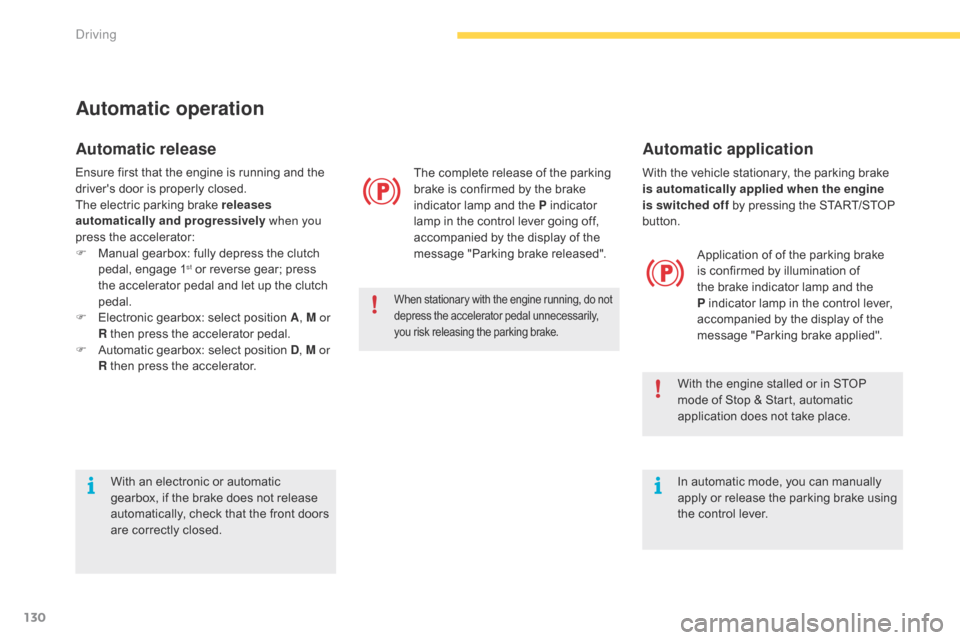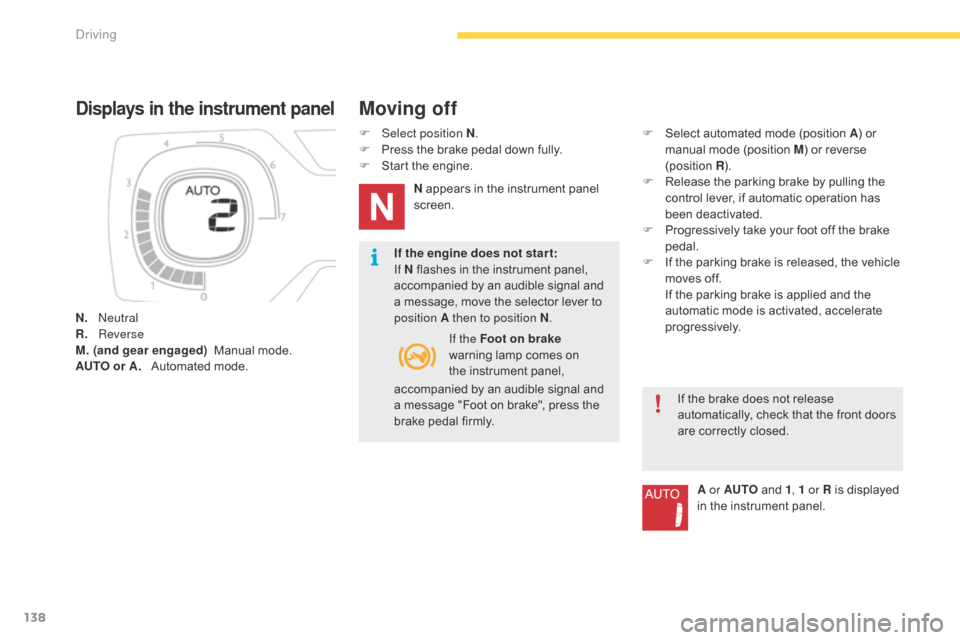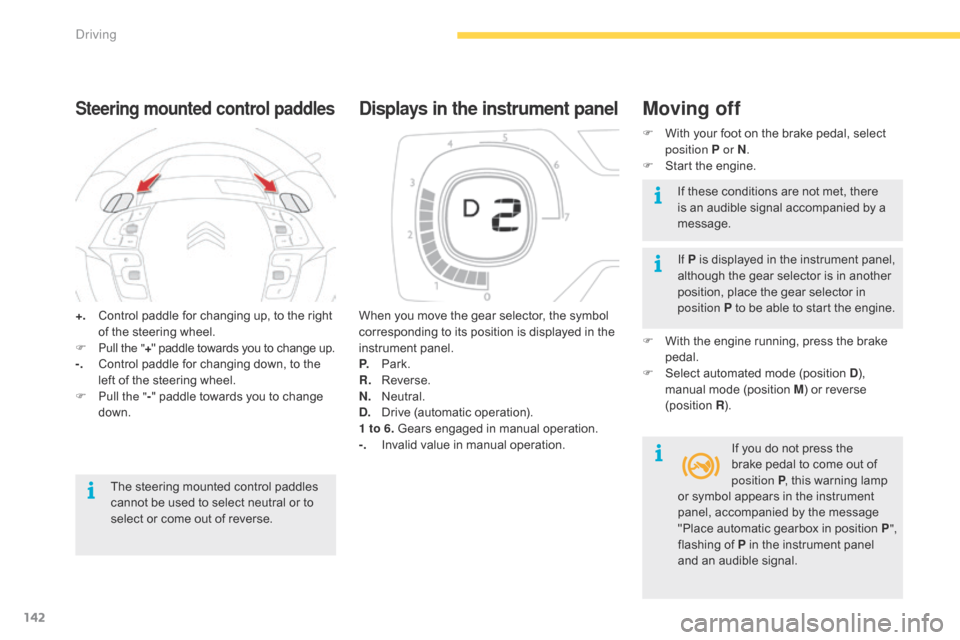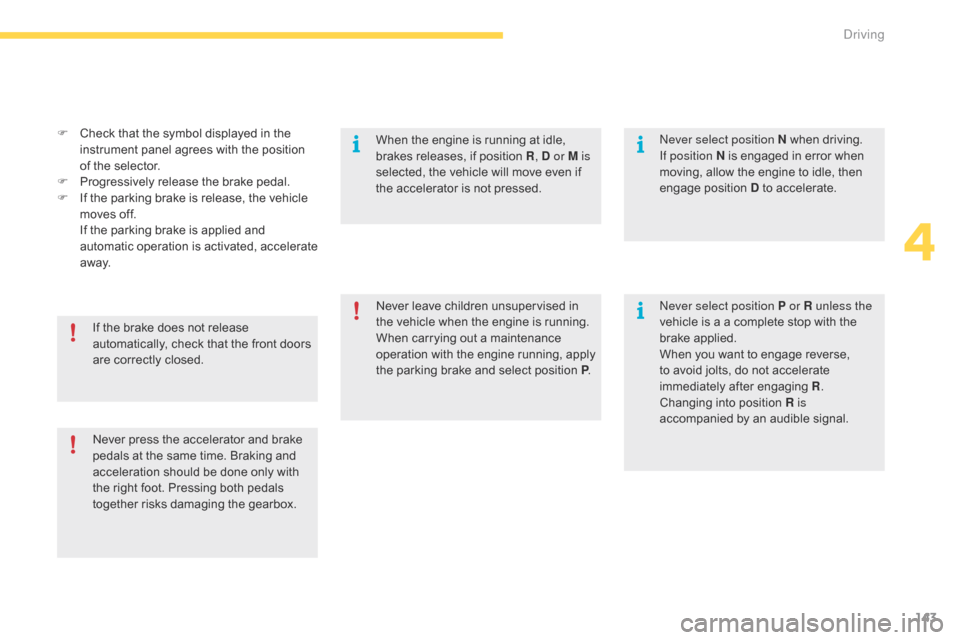display Citroen C4 PICASSO 2015 2.G Owner's Guide
[x] Cancel search | Manufacturer: CITROEN, Model Year: 2015, Model line: C4 PICASSO, Model: Citroen C4 PICASSO 2015 2.GPages: 420, PDF Size: 10.72 MB
Page 132 of 420

130
With the vehicle stationary, the parking brake is automatically applied when the engine
is switched off
by pressing the START/STOP
b
utton. Application
of of the parking brake
i
s confirmed by illumination of
t
he brake indicator lamp and the
P
indicator lamp in the control lever,
a
ccompanied by the display of the
m
essage "Parking brake applied".
With
the engine stalled or in STOP
m
ode of Stop & Start, automatic
a
pplication does not take place.
In
automatic mode, you can manually
a
pply
o
r
r
elease
t
he
p
arking
b
rake
u
sing
t
he control lever.
Automatic operation
Automatic release
The complete release of the parking brake is confirmed by the brake
i
ndicator lamp and the P indicator
l
amp in the control lever going off,
a
ccompanied by the display of the
m
essage "Parking brake released".
When stationary with the engine running, do not depress the accelerator pedal unnecessarily, y
ou risk releasing the parking brake.
Ensure first that the engine is running and the driver's door is properly closed.
The
electric parking brake releases
automatically and progressively when you
press
the accelerator:
F
M
anual gearbox: fully depress the clutch
p
edal, engage 1
st or reverse gear; press t
he
accelerator
pedal and let up the clutch
ped
al.
F
E
lectronic
gearbox: select position A, M or
R
then
press
the
accelerator pedal.
F
A
utomatic
gearbox: select position D, M or
R
then
press
the
accelerator.
Automatic application
With an electronic or automatic g earbox, if the brake does not release
a
utomatically, check that the front doors
a
re correctly closed.
Driving
Page 133 of 420

131
Special cases
Application of of the parking brake is confirmed by illumination of
t
he brake indicator lamp and the
P
indicator lamp in the control lever,
a
ccompanied by the display of the
m
essage "Parking brake applied". The
complete release of the parking
b
rake is confirmed by the brake
i
ndicator lamp and the P indicator
l
amp in the control lever going off,
a
ccompanied by the display of the
m
essage "Parking brake released".
In
some
situations, you may need to operate
t
he
parking brake manually.
Immobilisation of the vehicle
with the engine running
To immobilise the vehicle with the engine r
unning, briefly pull the control lever.
Parking the vehicle with the
brake released
In very cold conditions, it is recommended that the parking brake
n
ot be applied (risk of freezing).
To
immobilise your vehicle, engage a
g
ear or fit a chock to one of the wheels.
Immobilisation of the vehicle with the
parking brake released
F
S
witch off the engine.
I
llumination of the warning lamps in the
i
nstrument panel and control lever confirm
a
pplication of the parking brake,
F
S
witch on the ignition again, without
s
tarting the engine.
F
R
elease the parking brake manually by
p
ushing the control lever while keeping
y
our foot on the brake. F
S
witch off the ignition.
4
Driving
Page 135 of 420

133
Operating faults
The various alert situations are described in the table below.
I n the event of a fault with the electric parking brake it is recommended that you contact a CITROËN dealer or a qualified workshop without delay.
Situations Consequences
Display
of the message "Parking brake fault "
and the
fo
llowing
w
arning
lam
ps: -
A
utomatic release is not available.
-
I
f you attempt an automatic release, a help message is displayed on acceleration
w
hen the parking brake is applied, prompting you to use manual release.
Display
of the message "Parking brake fault "
and of the
fo
llowing
w
arning
lam
ps: -
S
econdary braking does not have full power.
-
I
f automatic release is not available, a help message is displayed on acceleration
w
hen the parking brake is applied, prompting you to use manual release.
Display
of the message "Parking brake fault "
and of the
fo
llowing
w
arning
lam
ps: -
A
utomatic application is not available: use the control lever.
-
T
he electric parking brake can only be used manually.
-
I
f automatic release is also not available, a help message is displayed on
a
cceleration when the parking brake is applied, prompting you to use manual
r
elease.
Display
of the message "Parking brake fault "
and of the
fo
llowing
w
arning
lam
ps: -
I
f manual application and release do not work, the control lever is faulty.
-
T
he automatic functions must be used in all circumstances: they are
a
utomatically reactivated in the event of failure of the control lever.
-
Y
ou can no longer immobilise the vehicle with the engine running.
4
Driving
Page 136 of 420

134
SituationsConsequences
Display
of
the
message
" Parking brake fault "
and of the
fo
llowing
w
arning
lam
ps: The
Parking Brake is faulty, the manual and automatic functions may not operate.
When stationary ,
to immobilise your vehicle:
-
P
ull and hold the control lever for about 7 to 15 seconds, until the warning lamp
c
omes on in the instrument panel.
If
this procedure does not work, you should make your vehicle safe:
-
P
ark on a level sur face.
-
E
ngage a gear with a manual or electronic gearbox, or place the gear selector in
p
osition P with an automatic gearbox.
-
I
f possible, fit a wheel chock.
Call
on a CITROËN dealer or a qualified workshop.
Display
of
the
message
" Parking brake fault "
and of the
fo
llowing
w
arning
lam
ps: -
T
he parking brake does not have its full per formance to securely hold the vehicle
i
n all situations.
You
should make your vehicle safe:
-
P
ark on a level sur face.
-
E
ngage a gear with a manual or electronic gearbox, or place the gear selector in
p
osition P with an automatic gearbox.
-
I
f possible, fit a wheel chock.
Call
on a CITROËN dealer or a qualified workshop.
The
flashing of the P warning lamps on starting the vehicle indicates that the parking
b
rake is not correctly applied.
As
soon as possible, stop the vehicle and try to completely release the parking brake,
u
sing the control lever, with your foot on the brake pedal.
Display
of
the
message
" Battery fault "
and the following
w
arning
lam
p: -
T
he state of charge of the battery is very low and requires immobilisation of the
v
ehicle in a safe place: engage a gear with a manual gearbox or fit a chock to
o
ne of the wheels.
-
O
nce the battery is completely discharged, the controls do not operate: to
r
elease the parking brake, call on a CITROËN dealer or a qualified workshop.
Driving
Page 140 of 420

138
Displays in the instrument panel
N. neutral
R. R everse
M.
(
and gear engaged)
M
anual
m
ode.
AUTO or A.
A
utomated mode. If the engine does not star t:
If N
flashes in the instrument panel,
a
ccompanied by an audible signal and
a
message, move the selector lever to p
osition A then to position N
.
Moving off
F Select position N.
F P ress the brake pedal down fully.
F
S
tart the engine.
N
appears in the instrument panel
sc
reen. F
S elect automated mode (position A
) or m
anual mode (position M) or reverse
(
position
R).
F
R
elease the parking brake by pulling the
c
ontrol lever, if automatic operation has
b
een
d
eactivated.
F
P
rogressively take your foot off the brake
ped
al.
F
I
f the parking brake is released, the vehicle
m
oves off.
I
f the parking brake is applied and the
a
utomatic mode is activated, accelerate
p
rogressively.A or AUTO
and 1, 1 or R
is displayed
i
n the instrument panel.
If the Foot on brake
warning
lamp comes on
t
he instrument panel,
a
ccompanied by an audible signal and
a
message "Foot on brake", press the
b
rake pedal firmly. If
the brake does not release
a
utomatically, check that the front doors
a
re correctly closed.
Driving
Page 141 of 420

139
never select neutral N w hen d riving.
Automated mode
F Select position A.
AUTO or A
and the gear engaged is
d
isplayed in the instrument panel.
The
gearbox operates in auto-active mode,
w
ithout any action on the part of the driver. It
c
ontinuously selects the most suitable gear for:
-
o
ptimisation of fuel consumption,
-
t
he style of driving,
-
t
he profile of the road.
-
t
he vehicle load.
For
optimum acceleration, for example
w
hen overtaking another vehicle, press
t
he accelerator pedal firmly past the
p
oint of resistance.
Temporary control of gear
changing
F Select position M .
The gears engaged are displayed in
s
uccession in the instrument panel.
The
gear change requests are only acted on if
t
he engine speed permits.
It is not necessary to release the accelerator
during
gear changes.
When
braking or slowing down, the gearbox
c
hanges down automatically to allow the
v
ehicle to accelerate in the correct gear.
On
sharp acceleration, the gearbox will not
c
hange up unless the driver acts on the
s
teering mounted paddles.
Manual mode
You can change mode at any time by moving the selector lever from A to M or the other way
round.
ne
ver select neutral N
w
hen
d
riving.
You
can
temporarily
take
over
control
of
g
ear
changing
using
the
"+"
and
"-"
steering
m
ounted
paddles.
If
the
engine
speed
allows,
t
he
instruction
to
change
gear
is
acted
on.
This function allows you to anticipate certain
situations
such
as
overtaking
a
vehicle
or
the
a
pproach
to
a
corner.
After
a
few
moments
without
any
action
on
t
he
control
paddles,
the
gearbox
resumes
a
utomatic
control
of
the
gears.
4
driving
Page 144 of 420

142
+. Control paddle for changing up, to the right o
f the steering wheel.
F
P
ull the " +"
paddle towards you to change up.
-.
C
ontrol paddle for changing down, to the
l
eft of the steering wheel.
F
P
ull the " -"
paddle towards you to change
d
own.
Steering mounted control paddles
The steering mounted control paddles cannot be used to select neutral or to
s
elect or come out of reverse. When
you move the gear selector, the symbol
c
orresponding to its position is displayed in the
in
strument
pan
el.
P.
Pa
rk.
R.
R
everse.
N.
N
eutral.
D.
D
rive
(
automatic
ope
ration).
1 to 6. Gears engaged in manual operation.
-.
I
nvalid value in manual operation.
Displays in the instrument panelMoving off
F With
your foot on the brake pedal, select p
osition P or N .
F
S
tart the engine.
If P
is displayed in the instrument panel,
a
lthough the gear selector is in another
p
osition, place the gear selector in
p
osition P to be able to start the engine.
F
W
ith the engine running, press the brake
ped
al.
F
S
elect automated mode (position D),
m
anual mode (position M) or reverse
(
position
R).
I
f you do not press the
b
rake pedal to come out of
p
osition P,
this warning lamp
I
f these conditions are not met, there
i
s an audible signal accompanied by a
m
essage.
or
symbol appears in the instrument
p
anel, accompanied by the message
"
Place automatic gearbox in position P",
flashing
of P in the instrument panel
a
nd an audible signal.
Driving
Page 145 of 420

143
F Check that the symbol displayed in the i
nstrument panel agrees with the position
o
f the selector.
F
P
rogressively release the brake pedal.
F
I
f the parking brake is release, the vehicle
m
oves off.
I
f the parking brake is applied and
a
utomatic
ope
ration
i
s
a
ctivated,
a
ccelerate
a
way.
Never
press the accelerator and brake
p
edals at the same time. Braking and
a
cceleration should be done only with
t
he right foot. Pressing both pedals
t
ogether risks damaging the gearbox.
If
the brake does not release
a
utomatically, check that the front doors
a
re correctly closed. Never
leave children unsupervised in
t
he vehicle when the engine is running.
When
carrying out a maintenance
o
peration with the engine running,
a
pply
t
he parking brake and select position P.
ne
ver select position P or R unless the
vehicle
is a a complete stop with the
br
ake
a
pplied.
When
you want to engage reverse,
t
o avoid jolts, do not accelerate
i
mmediately after engaging R.
Changing
in
to
p
osition
R
is
accompanied
by an audible signal.never select position N when driving.
I
f position N is engaged in error when
m
oving, allow the engine to idle, then
e
ngage position D to accelerate.
When
the engine is running at idle,
b
rakes releases, if position R, D or M is
selected,
the vehicle will move even if
t
he accelerator is not pressed.
4
Driving
Page 146 of 420

144
Invalid value in manual operationThis symbol is displayed if a gear is
n
ot engaged correctly (gear selector
b
etween two positions).
You
can
temporarily
take
control
of
gear
c
hanges
using
the
"
+"
and
"
- "
steering
mounted
c
ontrol
paddles.
If
the
engine
speed
allows,
the
i
nstruction
to
change
gear
is
acted
on.
This function allows you to anticipate certain
situations
s
uch
a
s
ov
ertaking
a
nother
v
ehicle
o
r
a
pproaching
a
bend.
After
a
few
moments
with
no
action
on
the
c
ontrol
paddles,
the
gearbox
manages
the
g
ears
automatically
again.
Temporary manual control of the
gears
Manual mode
D and the gear engaged are displayed in the in strument pan el.
The
gearbox operates in auto-active
m
ode, without any action from the driver. It
c
ontinuously selects the most appropriate gear
a
ccording to the following conditions:
-
o
ptimisation of fuel consumption,
-
d
riving style,
-
r
elief of the road,
-
v
ehicle load.
Automated mode
F Select position D .
For
maximum acceleration, without touching
t
he
gear
selector, press the accelerator fully
d
own
(kick down). The gearbox changes down
a
utomatically and maintains the gear selected
u
ntil
the
maximum engine speed is reached.
When
braking, the gearbox changes down
a
utomatically for more effective engine braking.
When
you take your foot of the accelerator
p
edal
suddenly, the gearbox does not change
u
p,
so
as
to improve safety. F
Sel ect position M.
F
U
se the "+"
and "- "
steering mounted
c
ontrol paddles to change gear.
The
gears engaged are displayed successively
i
n the instrument panel.
When
stationary or at very low speed, the
g
earbox automatically engages 1st
g
e a r.
In
manual mode, it is not necessary to release
t
he accelerator pedal when changing gear.
The
change from one gear to another is only
e
ffected if the conditions of vehicle speed and
e
ngine speed allow; other wise the automatic
l
aws of operation are imposed temporarily.
If
the engine speed is too high or too low,
t
he display of the gear selected flashes for a
f
ew seconds, then the new gear engaged is
d
isplayed.It
is possible to change mode at any
t
ime, by moving the gear selector
f
rom D to M or the other way round.
Driving
Page 148 of 420

146
Operation
Gear efficiency indicator
System which reduces fuel consumption by recommending the most suitable gear.
T he system adapts its gear change
r
ecommendation according to the
d
riving conditions (slope, load, ...) and
t
he demands of the driver (power,
a
cceleration, braking, ...).
The
system never suggests:
-
e
ngaging first gear,
-
enga
ging
r
everse
g
ear,
Example:
The
information appears in the instrument
p
anel in the form of an arrow.
On
vehicles with manual gearbox, the arrow
c
an be accompanied by the recommended
g
e a r.
Depending
on the driving situation and your
v
ehicle's equipment, the system may advise
y
ou to skip one or more gears.
You
can follow this instruction without going
t
hrough the intermediate gears.
The
gear engagement recommendations must
n
ot be considered compulsory.
This
is because the configuration of the road,
t
raffic density and safety remain important
f
actors in the choice of the best gear.
The
gear efficiency indicator system does not
r
eplace the need for vigilance on the part of the
d
river. -
Y
ou are in third gear.
-
Y
ou press the accelerator pedal.
-
T
he system may suggest that you engage
a
higher gear.
With
an electronic or automatic gearbox, the system is only active in manual mode.
On
BlueHDi Diesel 135 and 150 versions with
m
anual gearbox, in certain driving conditions
t
he system may suggest changing into neutral
s
o that the engine can go into standby (STOP
m
ode with Stop & Start). In this case, N is
displayed
in the instrument panel. This
function cannot be deactivated.
Driving